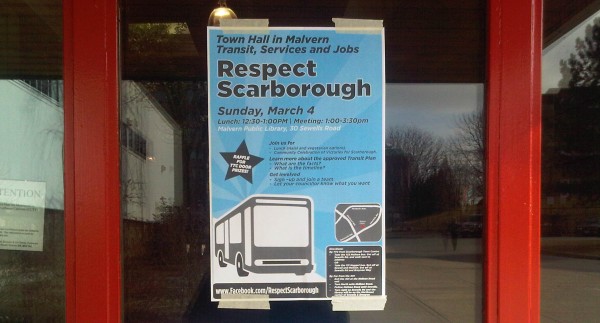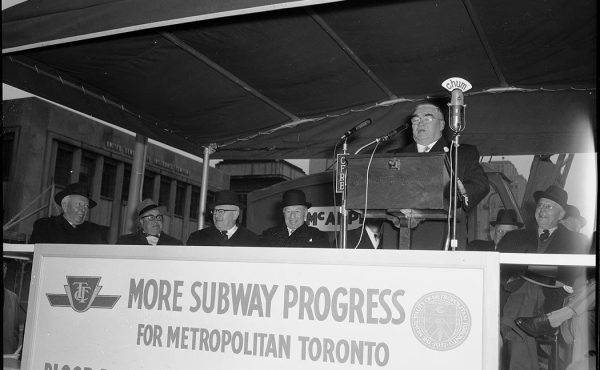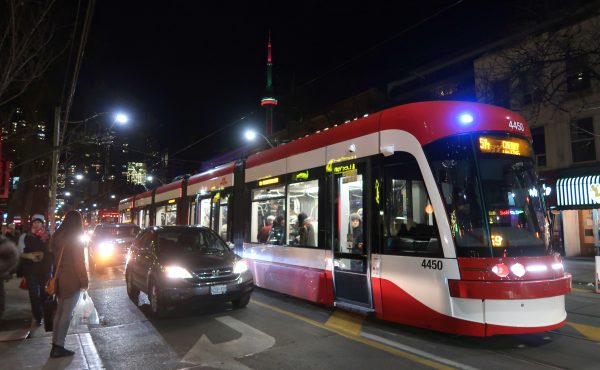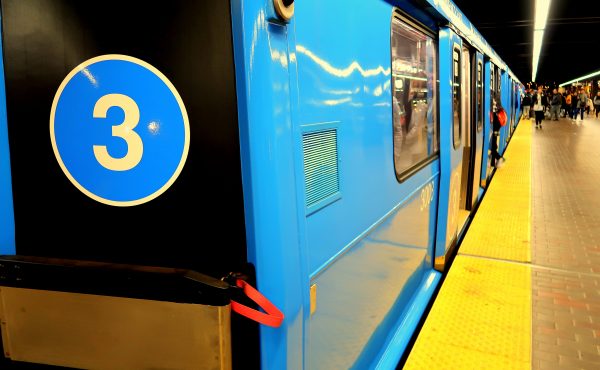When Toronto city council convened in July, 2013, to make a clear decision on the Scarborough subway conversion, City staff provided an estimate on the cost: $2.3 billion, as outlined in a PDF document. Three months later, Toronto council approved, by a vote of 24-20, a phased-in property tax increase that will raise $910 million over 30 years — a figure, its proponents claimed, that represented the final piece of the Scarborough subway funding puzzle.
By that point, the Ontario government had diverted $1.48 billion (2010 dollars) from the original Scarborough RT conversion funding envelope (about $350 million was transferred from the initial $1.8 billion Scarborough LRT budget to the Eglinton Crosstown project). And the federal Conservatives, responding to a direct appeal from Mayor Rob Ford, anted up another $660 million.
All in, the City has $3.05 billion in dedicated funds (2014 dollars), less the $85 million it owes to Metrolinx for sunk costs associated with the previous work done on the Scarborough LRT. At over $400 million per kilometre, the three-stop Scarborough line will be almost 33% more expensive than the Spadina extension (set to open in 2016), which is a kilometre longer and has twice as many stations.
But is that enormous sum even enough to build the Scarborough subway? Moreover, did council — and Queen’s Park — make this momentous decision with a full understanding of the costs?
From the beginning, Stintz and de Baeremaeker sought to minimize the additional expense, claiming that a subway was only $500 million more than the $1.8 billion LRT (for a total of $2.3 billion). By June 2013, according to briefing notes obtained by Spacing, Metrolinx officials, in discussions with the City and the ministry of transportation (MTO), were pegging the addiotnal costs at $925 million, meaning a subway would cost $2.7 billion.
But that $925 million may have been a low-ball estimate. Spacing obtained a May, 2013, “business case analysis,” prepared by John Howe, Metrolinx’s vice-president for investment strategy and sent to two senior provincial officials, Carol Layton and David Black, on June 28, 2013. It suggests the $3 billion overall subway cost estimate may fall hundreds of millions of dollars short of the mark. (Howe oversaw the Metrolinx effort to find new revenue tools to fund The Big Move.)
“The subway is at a very preliminary (pre-EA) design stage and therefore it is prudent to apply an optimism bias uplift, typically + 40% to 50% for Capital cost estimates,” the memo explains. “A lower rate of optimism bias uplift is applicable to the LRT scheme, reflecting a much more advanced status of the designs. Applying 45% optimism bias for the subway scheme and 12% optimism bias for the LRT scheme, a cost differential of $1.5 billion is derived.”
In other words, since the subway plans are very preliminary, the amount by which its costs might exceed the current estimate is much higher than for the well-developed LRT plans. That means that, once all the real-world expenses are tallied up, the subway could end up costing as much as $3.3 billion. According to the briefing note, that number doesn’t even include a range of other expenses, nor does it account for the fact that the original allocations are given in 2011 dollars.
Howe’s memo also outlined a range of other concerns relating to capital costs, operating implications and construction risk. Written well before council and the province hammered out a deal, this document is the clearest articulation of Metrolinx’s reservations about the proposed change in direction.
What’s more, the fact that these concerns were communicated to senior provincial officials in late June. 2013 indicates that Murray’s office would have — or should have — known about the financial analysis. There’s nothing on the record to indicate, however, that Murray publicly discussed the total possible cost, much of which would be born by Toronto taxpayers.
LOW RIDERSHIP PREDICTION
In addition to the costs issue, the Metrolinx memo addressed the problem of expected ridership. The travel forecast for 2031 on the Scarborough RT corridor shows a “maximum flow” of approximately 11,000 passengers per peak direction per hour. That figure IS not even half of a subway’s capacity (25,000 passengers), and less than the LRT capacity of 15,000 passengers. “It is therefore concluded that the additional capacity of subway technology is not required and does not add value to the scheme,” the memo stated. “This initial assessment suggests the volume of benefit likely required to justify the switch to subway construction will not be generated and the switch would not represent good value for money.
“While further analysis could create a more definitive statement,” the memo continued, “preliminary analysis indicates that the subway scheme will not represent a good use of public investment dollars….”
The Metrolinx memo also had warnings about the risk of further delay — as much as six years — given the current state of the Scarborough RT. “The SRT is considered life expired by the TTC who [sic] describe the state of the infrastructure and the vehicles as ‘approaching critical.’ It may therefore be necessary to provide bus replacement service for the SRT during all or part of this six year period.”
On the question of connecting transit investment to planning goals, the Metrolinx memo observes that new subway stations on the Scarborough line at Sheppard and McCowan, and Lawrence and McCowan “provide little or no opportunity to intensify land use in the vicinity of these stations, negating the potential to support provincial TOD [transit-oriented development] policies and to create growth nodes around these major transit interchange facilities.”
Finally, Howe flagged other significant cost question marks:
- The realignment of the line [PDF] under Scarborough Town Centre — the subway will pass beneath the mall whereas the LRT would have skirted to the south of the property — “is likely to be costly and will inconvenience users of the existing McCowan SRT station”;
- “The subway option is likely to eliminate the possibility of an extension of this corridor to Malvern Town Centre in the long term;”
- If the new GO interchange at Kennedy station becomes more popular with people traveling downtown, “the benefit of providing through service [on] the Bloor-Danforth subway to Scarborough…would diminish.”
“At this stage,” the Metrolinx memo warned MTO, “no further work to quantify or monetize these issues has been undertaken.”
As it turns out, these potential concerns excluded one other key element.
Part 4 on Monday: Won’t somebody think of Bombardier?
preface: Timeline
Part 1: The political machinations behind the Scarborough Subway
Part 2: “It’ll be over my dead body that Scarborough goes wanting for high speed transit”
Part 3: Ignoring the projected high costs and low ridership
Part 4: Won’t somebody think of Bombardier?
Part 5: The bottom line on the Scarborough subway line
photo by Himy Syed






6 comments
This series is great; the balance between detail and readability, achieved in part by spreading this investigation across 5 days, is the right mix for my morning crawl.
On Saturday 31 May at 13:00 (1pm) I’ll be leading a walk along the Scarborough LRT route. We’ll be discussing the issues raised by Spacing, plus route planning and other considerations as we walk along the route.
Please join us!
Details: http://www.soknacki2014.com/soknacki_to_lead_davids_walk
The persistent, partisan volatility in the process of identifying, choosing & building long-term public transit infrastructure, repeated over 25 years, means they’re never built as most don’t survive the short tenures of Toronto & Ontario politicians chosen in 3–4 year election cycles.
Metrolinx’s John Howe, that John Lorinc mentions as the author of the Scarborough subway BCA—Business Case Analysis is an honorable gentleman, a senior Ontario Civil Service veteran, without a partisan axe to grind. That said there is a shocking omission to Metrolinx’s BCA evaluation of Scarborough LRT vs. subways modes that damages the legitimacy of its conclusions.
Looking back to GTTA/Metrolinx’s original 2007 Mission (under CEO Michael Fenn & Chair Rob MacIssac), it was to integrate GTA public transit (fares & service). FF 2014, how’s it going? Nowhere!
Check out the Metrolinx website today** and there is a new generic Mission (introduced in 2009 by current Chair and then CEO) that is so hopelessly muddled & imprecise that it can’t be measured.
There is no mention of fare or service integration, no mention of GTA public transit’s modal share goal (of ~13.6M daily GTA trips*), no mention of customer quality, comfort, service, etc. Ditto for walking & cycling.
Despite this obvious omission, Metrolinx, and PT supporters like the Toronto Regional Board of Trade, Civic Action, Pembina Institute, Mayoral candidates… are promising the ‘BigMove’ will reduce GTA congestion, end gridlock…and other transportation miracles… or words to that effect.
A recent prime time Metrolinx TV ad, beautifully & professionally produced extols the virtue of GO Transit & the Union-Pearson Express and how “they will reduce congestion… along with other GTA rapid transit.” Excuse me, GO Transit’s ~65M annual rides, at ~1/8 the TTC’s 525M rides will not make a tinkers shred of difference to GTA congestion, nor will other GTA rapid transit Why?
Choosing the last 10 years (2003/2013) both GO Transit & TTC rides have enjoyed double-digit growth (GO: 44.3M—>65.3M; +47.4% — TTC: 405.4M—>525M; +29.6%; combined, TTC & GO are likely 90%+ of GTA PT rides & growth). What has happened to congestion & gridlock over this period? There are no GTA statistics I’m aware of, but, anecdotally they have both gotten much, much worse.
So a simple GTA fact check of “more public transit = less congestion & gridlock” shows it to be a complete sham—a false Metrolinx promise. Congestion is caused by too many vehicles on the roads, exacerbated in a growing region like the GTA (+100k ppl/yr.) where the vehicular growth more than offsets public transit ride growth.
So in the GTA and worldwide city regions congestion & gridlock are getting worse, year-by-year, regardless of transit use, growth, and maturity of its network (e.g. NYC, Paris) absent road pricing that will actually reduce daily vehicular traffic (e.g. London’s congestion & Singapore toll charges).
The Queen’s Scout & ethical Marketer in me is offended each time I see/hear Civic Action’s misleading “32” campaign which implies the ‘BigMove’ will reduce your current commute by 32 minutes once it is fully built in 2031. Closer reading reveals that your commute won’t INCREASE from ~77min currently, to 109min in 2031! FAIL!
I mean gees… these are big sophisticated organizations… but it seems public transit is exempt from the rational examination & detailed analysis of its cost-benefits in favour or vapid, wildly misleading if not fraudulent self-serving, partisan public transit spin—that doesn’t pass the simplest of ‘common sense’ smell tests.
In the current Scarborough LRT vs. Subway mode debate LRT supporters claim to adhere to “evidence- or fact-based public transit planning” and justify the LRT as it has more stops (7) vs. Subway (3), at ~1/3 cost per kilometer and is completely funded. So let’s build LRT, it’s common sense, right?
Applying this blinkered principle, we would never build higher order LRT or Subways, as it’s always possible to provide the same capacity with buses on mixed streets, or shared, dedicated bus lanes. Neither would have RC Harris built the Prince Edward Viaduct in 1918 with a lower subway deck that wouldn’t be utilized until 1966—almost 50 years later!
So back to the new Metrolinx Mission, now so generic as to be virtually unfathomable—watered down by its now Chair & former CEO, who despite being the product of privilege—a sociable, polished UCC old-boy, an elitist with 4 degrees, 3 of them from expensive, private US universities; one a Chicago MBA—doesn’t seem to familiar with the S.M.A.R.T. principle that business objectives, goals & missions should be: SPECIFIC, MEASURABLE, ACHIEVABLE, REALISTIC & TIME-dependent. Take a quick look:
The Metrolinx Mission, Then & Now:
2007: To champion, develop and implement an integrated transportation system for our region…
2009: To champion and deliver mobility solutions for the Greater Toronto and Hamilton Area.
Are we there yet? Who knows? Metrolinx’s indecipherable 2009 Mission is virtually useless in guiding GTA PT mode choice.
For example, we need to enunciate, something like:
1. Achieve GTA public transit 25% modal share (2011 MTO TT*: TO ~25%, 905 single-digit);
2. Travel to/from downtown Toronto (35% of its jobs) within 1 hour from anywhere in city;
3. Seamless travel across present 416/905 boundary w/o 100% fare penalty;
4. GTA One-Fare via 2-hour time based transfer.
To make 12/18/30+ year investment decisions without a network framework of overarching GTA transit goals to guide network mode choices is complete hooey—and yet that’s what Metrolinx, John Tory, Olivia Chow, Karen Stintz, David Soknacki, and their supporters, et al are doing!
After the Sheppard stubway’s low ridership, after the St. Clair LRT construction snafus, etc.… “Fooled me once shame on you, fooled me twice shame on me” …it’s no wonder the public is reluctant to have an ‘adult conversation’ on funding public transit when their proponents think they can fool all the people all the time on the true benefits of the proposed public transit investments.
*MTO Transportation Tomorrow Study 2011: http://www.dmg.utoronto.ca/pdf/tts/2011/tts2011_presentation.pdf
** Metrolinx Mission: http://www.metrolinx.com/en/aboutus/metrolinxoverview/metrolinx_overview.aspx
While at times I have respect for many Councillors (including deBaeremaeker who still bikes in a long distance to set an example to others including myself), the Council meeting in late 2013 was very painful given the mathemagics and strong whiff of misrepresentation. It did spawn a new term tho: Clowncil.
In the last set of bullets, it is interesting to see the internal thinking about the STC station location.
Any of the documents that have been released (including the PDF linked from the article!) show an alignment along McCowan, with a uselessly relocated STC station at McCowan and Progress, well away from the area from which the majority of riders are drawn. It is good to see that at least planners are trying to get it at least closer to the existing station location. (Of course, there hasn’t even been an EA started yet. An EA would be needed to consider alternative alignments and station technologies. If I wanted to be snarky, I would say that an EA should also consider alternate technologies!)
I think the Kennedy GO connection is a red herring. Kennedy GO may be new, but there are other comparable examples (Kipling GO; Bloor GO; Danforth GO) that also all have low ridership and low transfer activity. Partly related to fares, partly to schedule, partly to inconvenience of making transfer, partly to proximity to downtown destinations (the farther your destination is from Union Station, the less the time savings from the express trip on GO, especially if some of the time savings are eaten up by a transfer to service that runs less frequently than the subway).
Mr. Soknacki,
Two things to note on your walking tour.
1. The B-D subway extension go through some undevelopeable areas and is a complete waste of money.
2. The residents of Scarborough want and demand a connection to the heart of the City without a transfer, and have the demand to justify it.
The solution is to find a compromise. Connec the SRT/LRT with the ECLRT. To handle the extra passengers, elevate ECLRT from Kennedy to DVP. This can be done for about $500M – a far cry from the $1.5B needed from the B-D subway extension. This line would go from Malvern to Mount Dennis (and eventually Pearson), with connections to B-D subway for downtown north, GO for downtown Union, the DRL for the Financial Distric, Yonge for other parts of downtown, Spadina for York U, UofT south, Queens Park and Hospital row – and to Pearson with no transfer.
If you look at this logically, this compromise solution will not only satisfy many more people, it is far less expensive than the subway option. So please, instead of pursuing the expensive subway or the rejected SRT/LRT – look at the elevated Eglinton.